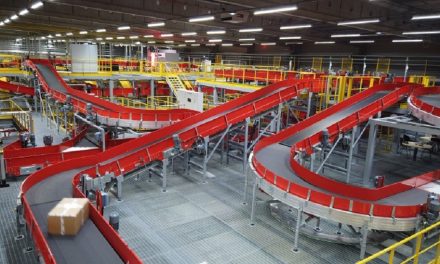
Middle East transport and logistics at a crossroads – an attractive opportunity for Post Offices?
The Middle East region is in the middle of exciting global, regional and local development in terms of transport and logistics. Will the Regional Post Offices be able to capitalize on these opportunities?
In centuries past, dusty caravans ferrying everything from spices to porcelain made their way along the Silk Road in the Middle East, a route prized for its connections to both Europe and Asia. As it turns out, those historic bands of traders only hinted at a vast transportation and logistics network that is now slowly emerging in the region and that could be a significant source of economic growth for many years to come.
The Middle East region’s excellent geographic location and very good accessibility by air, land, and sea put it in a prime position to serve as a trade hub, whether on a global scale or for regional and local markets. Consequently, the region has the opportunity to play a major role in the global transport and logistics industry supported by three main trends. First, the trade volume between Europe and Asia is likely to continue its strong growth pattern over the years to come as Asia has become a key production and manufacturing region for the western world. Traditionally, air freight carriers used to stopover in the Middle East to refuel, halfway along this trade lane, and will continue to do so to maximize freight loads. Second and more important, the Middle East will benefit from the volume growth on the Europe-Asia trade lane as shippers use larger vessels and apply more advanced logistics concepts. Both factors are driving the need for hubs along the trade lane, the ideal location for the hub being right in the middle of the trade lane, i.e. in the Middle East. Finally, the third driver of the Middle East as a growth area for global logistics along the Europe-Asia trade lane is the increasing need for multimodal hubs.
As product cycles speed up, demand becomes less predictable due to a broader variety of products, and companies manage their stock more closely, sea freight increases the risk of carrying outdated items. Because air freight remains too expensive for most goods, a new transport concept “acceleration in motion”, offering a conversion from cost effective sea to air freight while en-route, becomes more important. Given the distance and travel time between Europe and Asia, the Middle East is a natural location for sea-to-air conversion. In fact, Dubai has already made significant investments in the integration of its airport and seaport with an annual volume of more than 100,000 tons converted from sea to air transport. However, there are limited opportunities to establish global multimodal logistics hubs in the Middle East. Even on a global scale, there are very few truly global hubs – Los Angeles, New York, Amsterdam/Rotterdam, and Singapore. We predict that, at the most, there is an opportunity to establish two global hubs in the region; one position will soon be taken by Dubai, once its new airport becomes operational and its seaport expansion is completed. Furthermore to the opportunity arising from the growing Europe-Asia trade lane, the Middle East has the opportunity to establish the leading transport and logistics hubs for the broader region serving northern and middle Africa, Pakistan, and the Caucasian countries of the Commonwealth of Independent States (CIS).
Three key factors support the ability for Middle East hubs to establish such a positioning. Firstly, the Middle East has the advantage of a geographic location with equal proximity to all these markets and very good connectivity by road and short sea transport. Additionally, these markets currently lack access to competing regional centers, such as Europe and South Africa, and can not yet afford the required infrastructure investments. Secondly, the trend towards optimization of supply chains drives the allocation of regional headquarters and distribution centers in the Middle East. Global and larger regional players tend to follow a similar approach as in developed countries and consolidate Middle East stocks into one regional distribution center to drive profit generation and enhance customer service. Thirdly, the positive economic outlook for the consumption and the increasing production capacity in the Middle East supports the allocation of regional logistics and distribution centers for the wider region. Middle East governments are trying hard to establish local production base which will translate into a growing per capita consumption and emphasize the need for a strong logistics sector. However, despite the substantial efforts to grow the domestic production base, the broader region will, for the foreseeable future, remain strongly dependent on global imports. Hence, excellent global accessibility based on an extensive logistics infrastructure will be crucial for the establishment of such regional centers.
This already qualifies the global hub locations, such as Dubai, to play a significant role in regional distribution. In addition, a few further locations with strong local consumption market and very good logistics infrastructure, such as the main seaports in the Arabian Gulf, Mediterranean, and Red Sea, could qualify to become regional distribution centers. As Middle Eastern governments embark on the development of the transport and logistics sector to drive economic growth, it should be clear that the opportunities are notequally available to all countries. Hence, governments should consider five key building blocks for developing a successful transport and logistics sector strategy.
1. Choose a strategic play for the sector on a global level. The correct choice of the strategic play is the most difficult decision from a government perspective and needs to be based on a thorough and honest assessment of the qualifying factors. Fundamentally, there are three different strategic plays that governments can pursue for the transport and logistics sector. The global multimodal transport and logistics hub strategic play is the most demanding option, requiring a preferred geographic location and huge investments in infrastructure. It also demands an economic environment that attracts foreign direct investment; the availability of a large free zone around the port-airport infrastructure; evidence that the port and airport operator can smoothly manage complex processes; highly competitive handling charges; and living standards that meet the demands of a large expatriate community. The regional logistics and distribution hub strategic play requires similar critical success factor as a global multimodal hub but less demanding in terms of overall size and multimodality. However, the quality of services and processes must nevertheless adhere to the same high standards. The infrastructure must simultaneously provide good connections to global hubs and exporting countries, as well as excellent links to neighbouring regional markets. A few traditional gateways to the Middle East, such as the Nile Delta, the Red Sea ports, Kuwait’s coastal area, and the northern shores of the Gulf, could develop into regional hubs. Finally, if a country cannot meet the needs of a global or regional hub play, the government should focus its sector strategy on the development of domestic transport and logistics services. This option still requires the setup of appropriate infrastructure, such as excellent connections between the ports and the consumption or production markets and the provision of bonded or free zones near the consumption markets.
2. Focus infrastructure investments to fit the chosen sector play. The choice of the strategic play determines the required infrastructure investments. A global multimodal hub strategy requires the development of a single mega-infrastructure incorporating a world-class airport and port zone. A regional logistics and distribution hub play requires the establishment of an appropriate road and short sea infrastructure on a regional level. And a domestic-focused transport and logistics services play requires the development of road infrastructure to provide connectivity to regional distribution centers and ports.
3. Adjust policies and regulations to promote sector development. The set of policies and regulations necessary for the development of both global multimodal and regional hub strategies can be adapted from world-class logistics centers, such as Rotterdam, Singapore, or Dubai. In essence, these policies and regulations should promote foreign direct investment, provide a liberal economic environment, and allow for full foreign ownership of the respective local entities.
4. Optimize government services to meet the demand of the logistics sector. The key government services required by the logistics sector fall into three areas: business and equipment licensing, regulatory oversight and competitive regulation, and customs services. Optimization of government services in the first two areas should be part of a broader economic development program to promote and foster entrepreneurial activity. Transactional customs services should be automated as much as possible and seamlessly integrated into the logistics service providers’ order management systems.
5. Promote the development of national transport and logistics champions. In most Middle Eastern countries, the industry structure of transport carriers and logistics service providers is still highly fragmented and often not well developed. Leading global logistics players are dominating these markets as a strong base on nation-wide, medium-to-large logistics service providers is lacking. Even with a liberal market approach, governments can actively promote and influence the development of the industry toward a target structure with stronger national transport and logistics champions. Like in other geographies, such as Europe, postal offices are starting now to understand their very good positioning in the transport and logistics market and with the support of their government they begin to capitalize on theses attractive opportunities. E.g. Emirates Post and Saudi Post have started joint ventures or acquired companies in the transport and logistics business and it can be expected that others will follow this path. The Middle East region is favourably located along the substantially growing Europe-Asia trade lane and in the middle of a broader region spanning from northern Africa to the southern borders of Russia and to Pakistan. This location provides a broad variety of opportunities for the Middle East to gain a fair share of the global and broader regional transport and logistics business. The development of a strong domestic transport and logistics sector is a strategic imperative for further economic development of the Middle Eastern countries. The countries that succeed at establishing sustainable transportation and logistics networks can expect to see a number of benefits: increased economic activity, improved industry competitiveness as foreign challengers come into the market, and growth in job opportunities. Those that do not, however, may find themselves falling by the wayside on the well-traveled Silk Road.
BIOS([email protected]) is a Vice President in Booz Allen Hamilton’s Beirut office. Mr. Majdalani is the leader of Booz Allen Hamilton’s Middle East Transportation Industry Practice.
Fadi Majdalani
Alexander Niehues ([email protected]) is a Vice President in Booz Allen Hamilton’s Munich office. He is heading Booz Allen Hamilton’s global Postal & Logistics Practice.
Ulrich Koegler ([email protected]) is a Principal in Booz Allen Hamilton’s Dusseldorf office.
Simon Kuge ([email protected]) is a Senior Associate in Booz Allen Hamilton’s Munich office.













